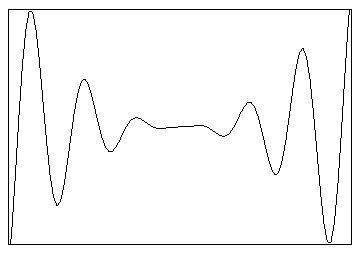Problem Set Eight, CS 257
Due at 11:59pm on Thursday Apr 22, 1999
[Software] quality has much in common with sex. Everybody is for it.
(Under certain conditions, of course.) Everyone feels they understand
it. (Even though they wouldn't want to explain it.) Everyone thinks
execution is only a matter of following natural inclinations. (After
all, we do get along somehow.) And, of course, most people feel that
problems in these areas are caused by other people. (If only
they would take the time to do things right.)
Philip Crosby
This is more of a programming project than just a problem set.
Goal
write a simple Scheme Graphing Calculator.
Interface
The interface is quite Scheme-y, you do not need any flashing input
thing. Users just type expressions to Scheme, but you have defined
some nice functions that they can use.
First, they need a ``little language'' in which to write their
mathematical expressions to be plotted. This language is minimal:
- a (real) number is an expression in the language
- the symbol x is an expression in the language
- (boperator expression expression) is an
expression in the language, where boperator is either
* or +
- (uoperator expression) is an
expression in the language, where uoperator is either
sin,
cos,
or
exp.
Note that in this little language the arithmetic operators always take
exactly two arguments, and there is no subtraction. So to subtract
the cosine of x from e to the x cubed you would use (+ (exp (* (*
x x) x)) (* -1 (cos x))). The trigonometric functions take their
arguments in radians, for ease of implementation and ease of
calculating derivatives. Also note that the only ``variable'' is x;
we will not need any more. (The simplicity of this little language
makes your job easier.)
Here are the functions you need to write:
- Define ceval which, given an expression in the little
languag above and a value for x, returns the appropriate numeric
result. Eg (ceval '(* x (+ x 1)) 2) yields 6. Note: do not
call the system eval in your code.
- Define cdiff which takes an express in the little
language above and returns its symbolic derivative with
respect to x, in the little language above. (For extra credit, make
sure the expression returned is simplified, without sacrificing
correctness of course.)
- Define graph which takes an expression in the little
language above, along with an x minimum and maximum, a y minimum and
maximum, and a number of points to evaluate n. It returns a graphic
object which is a plot of the given expression over the given range,
with the y axis covering the given range. The expression passed
should be evaluated at the given number of points, evenly spaced along
the x axis in the range given, and the while thing should be
surrounded by a nice box. (For extra credit, allow the user to pass
#t for either of the y axis bounds, and in that case you should
automatically calculate that part of the y bound to fit the data.)
You don't need to label the axes or put in tic marks or such.
Example: (graph '(* (sin x) (* x x)) -20 20 -300 300 200)
would plot x2sin x from x=-20 to 20, with
the y axis running from -300 to 300, and would evaluate the expression
at 200 x points. It would produce a graphic object that looks
about like this:

- Define dgraph which is just like graph except
that it takes an additional argument right after the expression, which
is how many derivatives of the function to plot. So for instance
(dgraph '(* (sin x) (* x x)) 0 -20 20 -300 300 200) does
exactly the same as the previous example, while (dgraph '(* (sin
x) (* x x)) 2 -20 20 -300 300 200) would, in addition to the
information on the graph described above, would also put onto the plot
a curve for the first derivative of x2 sin x,
namely x2 cos x + 2 x sin x, as well as the second
derivative, - x2 sin x + 4 x cos x + 2 sin x.
Barak Pearlmutter <bap@cs.unm.edu>
